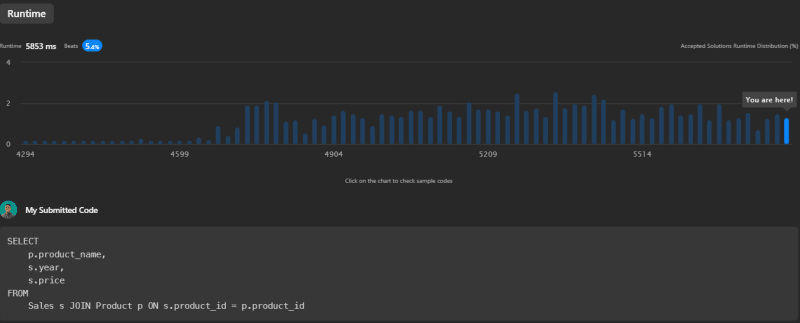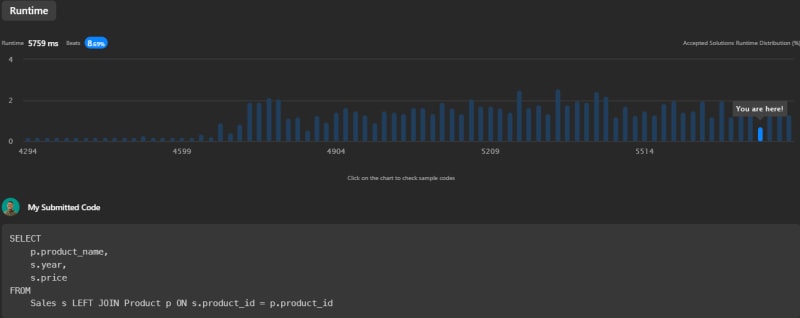The Problem
In this problem, we are given two tables: Sales and Product:
Sales Table:
| Column Name | Type |
|---|---|
| sale_id | int |
| product_id | int |
| year | int |
| quantity | int |
| price | int |
Product Table:
| Column Name | Type |
|---|---|
| product_id | int |
| product_name | varchar |
Our task is to write an SQL query that reports the product_name, year, and price for each sale_id in the Sales table. We must return the resulting table in any order.
For example, given the following tables:
Sales:
| sale_id | product_id | year | quantity | price |
|---|---|---|---|---|
| 1 | 100 | 2008 | 10 | 5000 |
| 2 | 100 | 2009 | 12 | 5000 |
| 7 | 200 | 2011 | 15 | 9000 |
Product:
| product_id | product_name |
|---|---|
| 100 | Nokia |
| 200 | Apple |
| 300 | Samsung |
The output would be:
| product_name | year | price |
|---|---|---|
| Nokia | 2008 | 5000 |
| Nokia | 2009 | 5000 |
| Apple | 2011 | 9000 |
The Solution
To solve this problem, we will join the Sales and Product tables using different types of joins and see which one yields the best performance. The type of join will affect the performance and the output depending on the underlying dataset and the SQL database management system.
Source Code 1
In this solution, we use an INNER JOIN to combine rows from Sales and Product where the product_id matches. The INNER JOIN keyword selects records that have matching values in both tables.
SELECT
p.product_name,
s.year,
s.price
FROM
Sales s JOIN Product p ON s.product_id = p.product_id
This solution has a runtime of 5853ms and it's faster than 5.4% of all SQL online submissions for this problem.

Source Code 2
In this solution, we use a LEFT JOIN to combine rows from Sales and Product where the product_id matches. The LEFT JOIN keyword returns all records from the left table (Sales), and the matched records from the right table (Product).
SELECT
p.product_name,
s.year,
s.price
FROM
Sales s LEFT JOIN Product p ON s.product_id = p.product_id
This solution has a runtime of 5759ms and it's faster than 8.69% of all SQL online submissions for this problem.

Source Code 3
In this solution, we use the same INNER JOIN as in Source Code 1, but we put the join operation in a subquery. A subquery, also known as an inner query or nested query, is a query within another SQL query and embedded within the WHERE clause.
SELECT a.*
FROM (
SELECT
p.product_name,
s.year,
s.price
FROM
Sales s JOIN Product p ON s.product_id = p.product_id
) a
This solution has a runtime of 5329ms and it's faster than 46.12% of all SQL online submissions for this problem.

Source Code 4
In this solution, we use a RIGHT JOIN to combine rows from Sales and Product where the product_id matches. The RIGHT JOIN keyword returns all records from the right table (Sales), and the matched records from the left table (Product). The DISTINCT keyword is used to eliminate duplicate records from the result set. If there is no match, the result is NULL on the left side. This code will return each unique combination of product_name, year, and price where the product_id in Sales matches the product_id in Product.
SELECT DISTINCT
p.product_name,
s.year,
s.price
FROM
Product p RIGHT JOIN Sales s ON s.product_id = p.product_id
This solution has a runtime of 5274ms and it's faster than 51.8% of all SQL online submissions for this problem.

Source Code 5
This solution is identical to Source Code 1, but with the addition of the DISTINCT keyword. DISTINCT is used to remove duplicate rows from the result set.
SELECT DISTINCT
p.product_name,
s.year,
s.price
FROM
Sales s JOIN Product p ON s.product_id = p.product_id
This solution has a runtime of 5624ms and it's faster than 18.97% of all SQL online submissions for this problem.

Conclusion
All the solutions presented above yield the correct result, but with different performances. Based on the runtime, the rank of the solutions from fastest to slowest is:
- Source Code 4 (5274ms)
- Source Code 3 (5329ms)
- Source Code 5 (5624ms)
- Source Code 2 (5759ms)
- Source Code 1 (5853ms)
It's interesting to note that using a RIGHT JOIN (Source Code 4) results in the best performance on LeetCode. However, in real-world RDBMS, the performance might vary depending on the specific dataset and indexing strategies.
Always bear in mind that understanding the problem thoroughly and choosing the right approach based on the context is the key to writing efficient SQL queries.
You can find the original problem at LeetCode.
For more insightful solutions and tech-related content, feel free to connect with me on my Beacons page.







Top comments (0)